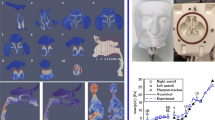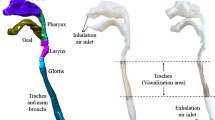Abstract
In this article, the results of numerical simulations using computational fluid dynamics (CFD) and a comparison with experiments performed with phase Doppler anemometry are presented. The simulations and experiments were conducted in a realistic model of the human airways, which comprised the throat, trachea and tracheobronchial tree up to the fourth generation. A full inspiration/expiration breathing cycle was used with tidal volumes 0.5 and 1 L, which correspond to a sedentary regime and deep breath, respectively. The length of the entire breathing cycle was 4 s, with inspiration and expiration each lasting 2 s. As a boundary condition for the CFD simulations, experimentally obtained flow rate distribution in 10 terminal airways was used with zero pressure resistance at the throat inlet. CCM+ CFD code (Adapco) was used with an SST k-\(\upomega \) low-Reynolds Number RANS model. The total number of polyhedral control volumes was 2.6 million with a time step of 0.001 s. Comparisons were made at several points in eight cross sections selected according to experiments in the trachea and the left and right bronchi. The results agree well with experiments involving the oscillation (temporal relocation) of flow structures in the majority of the cross sections and individual local positions. Velocity field simulation in several cross sections shows a very unstable flow field, which originates in the tracheal laryngeal jet and propagates far downstream with the formation of separation zones in both left and right airways. The RANS simulation agrees with the experiments in almost all the cross sections and shows unstable local flow structures and a quantitatively acceptable solution for the time-averaged flow field.






















Similar content being viewed by others
References
Agnihotri V, Ghorbaniasl G, Verbanck S, Lacor C (2014) On the multiple LES frozen field approach for the prediction of particle deposition in the human upper respiratory tract. J Aerosol Sci 68:58–72
Ball CG, Uddin M, Pollard A (2008) High resolution turbulence modelling of airflow in an idealized human extra-thoracic airway. Comput Fluids 37:943–964
Brücker C, Schröder W (2003) Flow visualization in a model of the bronchial tree in the human lung airways via 3-D PIV, Proceedings of the 4th pacific symposium on flow visualization and image processing (PSFVIP-4), Chamonix, France, 3-5 june 2003
Chen J, Gutmark E (2014) Numerical investigation of airflow in an idealized human extra-thoracic airway: a comparison study. Biomech Model Mechanobiol 13:205–214. doi:10.1007/s10237-013-0496-x
Cui XG, Gutheil E (2011) Large eddy simulation of the unsteady flow-field in an idealized human mouth-throat configuration. J Biomech 44:2768–2774
Ghahramani E, Abouali O, Emdad H, Ahmadi G (2014) Numerical analysis of stochastic dispersion of micro-particles in turbulent flows in a realistic model of human nasal/upper airway. J Aerosol Sci 67:188–206
Ghalati PF, Keshavarzian E, Abouali O, Faramarzi A, Tu J, Shakibafard A (2012) Numerical analysis of micro-and nano-particle deposition in a realistic human upper airway. Comput Biol Med 42:39–49
Heenan AF, Matida EA, Pollard A, Finlay WH (2003) Experimental measurements and computational modeling of the flow in an idealized extrathoracic airway. Exp Fluids 35:70–84
Horsfield K, Dart G, Olson DE, Filley GF, Cumming G (1971) Models of the human bronchial tree. J Appl Physiol 31:207–217
Huang J, Sun H, Liu C, Zhang L (2013) Moving boundary simulation of airflow and micro-particle deposition in the human extra-thoracic airway under steady inspiration. Part I: airflow. Eur J Mech B Fluids 37:29–41
Jayaraju ST, Brouns M, Verbanck S, Lacor C (2007) Fluid flow and particle deposition analysis in a realistic extrathoracic airway model using unstructured grids. J Aerosol Sci 38:494–508
Jedelsky J, Lízal F, Jícha M (2012) Characteristics of turbulent particle transport in human airways under steady and cyclic flows. Int J Heat Fluid Flow 35:84–92
Johnstone A, Uddin M, Pollard A, Heenan A, Finley WH (2004) The flow inside an idealised form of the human extra-thoracic airway. Exp Fluids 37(5):673–689
Kaye SR, Phillips CG (1997) The influence of the branching pattern of the conduction airways on the flow and aerosol deposition parameters in the human, dog, rat and hamster. J Aerosol Sci 28:1291–1300
Leschziner MA (1993) Introduction to the modeling of turbulence. Von Karman Institute for Fluid Dynamics, Lecture series. 1993–02, ISSN: 0377–8312
Li Z, Kleinstreuer C, Zhang Z (2007) Simulation of airflow fields and microparticle deposition in realistic human lung airway models. Part I: airflow patterns. Eur J Mech B Fluids 26:632–649
Lin CL, Tawhai MH, McLennanc G, Hoffman EA (2007) Characteristics of the turbulent laryngeal jet and its effect on airflow in the human intra-thoracic airways. Respir Physiol Neurobiol 157:295–309
Lízal F, Elcner J, Hopke P, Jedelský J, Jícha M (2011) Development of a realistic human airway model. ProcIMechE Part H. J Eng Med 226(H3):197–207. ISSN: 0954-4119
Longest PW, Vinchurkar S, Martonen TB (2006) Transport and deposition of respiratory aerosols in models of childhood asthma. J Aerosol Sci 37:1234–1257
Longest PW, Holbrook LT (2012) In silico models of aerosol delivery to the respiratory tract—development and applications. Adv Drug Deliv Rev 64:296–311
Luo XY, Hinton JS, Liew TT, Tan KK (2004) LES modelling of flow in a simple airway model. Med Eng Phys 26:403–413
Lyn DA, Einav S, Rodi W, Park JH (1995) A laser-doppler velocimetry study of ensemble-averaged characteristics of the turbulent near wake of a square cylinder. J Fluid Mech 304:285–319
Mihaescu M, Murugappan S, Kalra M, Khosla S, Gutmark E (2008) Large Eddy simulation and Reynolds-averaged Navier–Stokes modeling of flow in a realistic pharyngeal airway model: an investigation of obstructive sleep apnea. J Biomech 41:2279–2288
Nowak N, Kakade PP, Annapragada AA (2003) Computational fluid dynamics simulation of airflow and aerosol deposition in human lungs. J Biomed Eng 31:374–390
Pollard A, Uddin M, Shinneeb AM, Ball CG (2012) Recent advances and key challenges in investigations of the flow inside human oro-pharyngeal-laryngeal airway. Int J Comput Fluid Dyn 26(6–8):363–381
Piglione MC, Fontana D, Vanni M (2012) Simulation of particle deposition in human central airways. Eur J Mech B Fluids 31:91–101
Pope SB (2003) Turbulent flow. Cambridge University Press, Cambridge
Schmidt A, Zidowitz S, Kriete A, Denhard T, Krass S, Peitgen HO (2004) A digital reference model of the human bronchial tree. Comput Med Imaging Gr 28:203–211
Soni B, Aliabadi S (2013) Large-scale CFD simulations of airflow and particle deposition in lung airway. Comput Fluids 88:804–812
Taulbee DB, Yu CP (1975) A theory of aerosol deposition in the human respiratory tract. J Appl Physiol. 38(1):77–85
Tropea C, Yarin A, Foss J (ed) (2007) Handbook of experimental fluid mechanics. Springer, Berlin. ISBN: 978-3-540-25141-5
User Guide STAR-CCM+, Version 8.02
VKI Lecture series 1993–2002, 1993 Introduction to the modeling of turbulence
Wang Y, Elghobashi S (2014) On locating the obstruction in the upper airway via numerical simulation. Respir Phys Neurobiol 193:1–10
Weibel E (1963) Morphometry of the Human Lung. Springer Verlag and Academic Press, Berlin, New York
Wilcox DC (2000) Turbulence modeling for CFD, 2nd edition, DCW Industries, Inc., ISBN: 0-963051-5-1
Zarogoulidis P, Papanas N, Kouliatsis G, Spyratos D, Zarogoulidis K, Maltezos E (2011) Inhaled insulin: too soon to be forgotten? J Aerosol Med Pulm Drug Deliv 24(5):213–223
Zhang Z, Kleinstreuer C (2003) Low-Reynolds-number turbulent flows in locally constricted conduits: a comparison study. Am Inst Aeronaut Astronaut J (AIAAJ) 41:831–840
Zhang Z, Kleinstreuer C (2011) Computational analysis of airflow and nanoparticle deposition in a combined nasal–oral–tracheobronchial airway model. J Aerosol Sci 42(3):174–194
Acknowledgments
This work was supported by Project GA P105/11/1339 and funded by the Czech Science Foundation and Project LO1202 NETME CENTRE PLUS with financial support from the Ministry of Education, Youth and Sports of the Czech Republic under the “National Sustainability Programme I.” Frantisek Lizal and Michaela Chovancova were supported by Project CZ.1.07/2.3.00/30.0039 of Brno University of Technology.
Author information
Authors and Affiliations
Corresponding author
Electronic supplementary material
Below is the link to the electronic supplementary material.
Rights and permissions
About this article
Cite this article
Elcner, J., Lizal, F., Jedelsky, J. et al. Numerical investigation of inspiratory airflow in a realistic model of the human tracheobronchial airways and a comparison with experimental results. Biomech Model Mechanobiol 15, 447–469 (2016). https://doi.org/10.1007/s10237-015-0701-1
Received:
Accepted:
Published:
Issue Date:
DOI: https://doi.org/10.1007/s10237-015-0701-1




